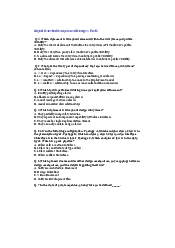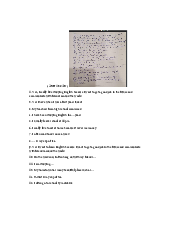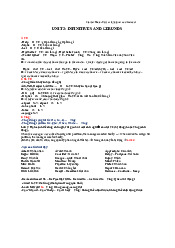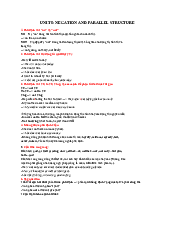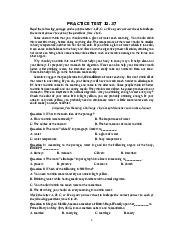


















































Preview text:
UNIT 11
HUMAN RESOURCE STRATEGIES Pre-reading
1.What is the importance of human resource strategies?
2.What should companies do to have effective human resource strategies?
A. READING COMPREHENSION
WHAT ARE HRM STRATEGIES?
HRM stands for Human Resource Management, and human resource management
strategies are the plans that lead to implementing different functions in the human
resources department of an organization.
Typically, these strategies are guided by the overall strategies of the business and serve
to help the business attain its long-term goals via its staff. These strategies can be divided into four key areas: Talent Leadership Planning Performance Culture Talent
Talent represents the human capital of an organization and is crucial to the success of
that business. It is an important asset that the business should strive to maintain. How
does the human resources management system help with these? By having a
comprehensive staffing blueprint. The human resources department should forecast the
staffing needs of the business in the future while also recruiting, hiring, and keeping the
best talent in the organization. The most successful businesses in the world pride
themselves in hiring the best talent in the world.
In order to do this effectively, the HRM department needs to identify the various
competencies required for each job, such as the skills, abilities, and knowledge required
to perform various tasks effectively. This will allow them to draw detailed job
descriptions that will ultimately guide them to find the best people for the job. Leadership
University of Labour and Social Affairs 115
The leadership of the organization is likened to what the head is to a body. It is through
leadership that a business succeeds or fails in its endeavors. The HRM department
plays a key role in the leadership of the organization because it is tasked with finding
the best executives to steer the business in the right direction.
An HRM department that can boast past success in choosing the right executives will
generally find it easier to convince the board of its recruits the next time an executive is
required. In order to do this job effectively, HR managers need to be active in an
advisory capacity when engaging with other organizational leaders so as to give their
input on what is the best for the company’s future. Planning
The HRM department plays an important role in helping the business to plan for the
future. Take employees, for example: by conducting regular surveys of the employees
to determine employee satisfaction, the HRM department can give important insights to
business leaders on what needs to be done in the future to contribute to a happier workplace. Performance Culture
An organization with well-defined performance metrics is an organization with high
potential for success. The HRM department plays a role in this, as well. Through
developing well-defined performance metrics, regular performance evaluations, and
schemes to reward employees for high performance and creativity in accomplishing
their tasks, the HRM department will create a high-performance culture where the
interests of the employees are aligned with those of the business, and they are
genuinely motivated to do their best. Employees who feel appreciated by their
companies and receive recognition for their achievements in the workplace are likely to want to do more.
By Nicole LaMarco; Updated June 26, 2018
Answer the questions below.
1. What are human resource management strategies guided by?
……………………………………………………………………………………………
……………………………………………………………………………………………
2. What is an important asset that the business should strive to maintain?
……………………………………………………………………………………………
……………………………………………………………………………………………
University of Labour and Social Affairs 116
3. What does the HRM department need to do to help the business find the best people for the job?
……………………………………………………………………………………………
……………………………………………………………………………………………
4. Why does the HRM department play a key role in the leadership of the organization?
……………………………………………………………………………………………
……………………………………………………………………………………………
5. When are employees likely to want to do more?
……………………………………………………………………………………………
…………………………………………………………………………………………… B.GRAMMAR
GERUNDS AND INFINITIVES I. GERUND 1. Chức năng:
Là chủ ngữ của câu: Dancing bored him
Bổ ngữ của động từ: Her hobby is painting
Là bổ ngữ: Seeing is believing
Sau giới từ: He is interested in watching films on Tv.
Sau một vài động từ: avoid, mind, enjoy.........
2. Một số cách dùng đặc biệt:
a. Verb + V-ing: Danh động từ theo sau một số động từ: Admit: thú nhận
Anticipate: trông mong, mong đợi Avoid: tránh Appreciate: tán thành Consider: xem xét Delay: hoãn lại Defer: trì hoãn Deny: từ chối Detest: ghét Dislike: không thích
University of Labour and Social Affairs 117 Dread: sợ Enjoy: thích thú Escape: trốn thoát Excuse: thứ lỗi Fancy: đam mê Finis h Forgive: tha thứ Like: thích Love: yêu thích Imagine: tưởng tượng
Involve: dính líu, liên quan Keep: giữ, tiếp Mind: phiền Miss: lỡ, nhớ Mention: đề cập Pardon: tha thứ, tha lỗi Prefer Prevent: ngăn ngừa Postpone: hoãn lại Practice: thực hành Prevent Propose (= suggest) Quit: từ bỏ Recollect: nhớ lại Resent: căm thù
Recall: gợi nhớ/ recollect Resume: cho rằng
Resist : kháng cự, ngăn cản Risk : mạo hiểm Remember/ forget Suggest: gợi ý Stop/ begin/ star t Understand: hiểu Discuss: thảo luận Hate: ghét
Ex: He admitted taking the money. He detests writing letters.
He didn’t want to risk getting wet. I can’t understand his/ him leaving his wife.
Chú ý: excuse, forgive, pardon, prevent không trực tiếp theo sau bởi danh động từ mà theo sau bởi:
Possessive adjective/ pronoun + danh động từ hoặc pronoun + preposition + danh động từ
Appreciate thường theo sau bở tính từ sở hữu hoặc danh động từ ở dạng bị động
University of Labour and Social Affairs 118
Ex: Forgive my/ me ringing you up so early.
Forgive me for ringing you up so early.
You can’t prevent his/ him spending his own money.
You can’t prevent him from spending his own money.
I appreciate your giving me o much of your time./ I appreciate being given this opportunity.
b. common phrasal verbs + V-ing: (sau một số cụm động từ)
carry on, end up, give up, go round, keep on, put off, set about…
Ex: He gave up smoking last year.
c. Expression + V-ing: Một số thành ngữ theo sau bởi V-ing
- have fun/ a good time + V-ing : vui vẻ …
- have trouble/ difficulty + V- ing:
- have a hard time/ difficult time + V-in g - spend + time/ money + V-ing (present participle)
Ex: He spends 3 hours studying English every day.
- waste + time/money + V-ing :
- sit + Danh từ nơi chốn + V-ing : she sat at her desk writing a letter
- stand + danh từ nơi chốn + V-ing
- lie + danh từ nơi chốn + Ving
- can’t help = can’t bear = can’t stand = can’t resist (không thể chịu được)
Ex: I can’t bear hearing his lies I can’t stand seeing him here
- it is no good / it is no use (vô ích / không có ích) :
Eg: It’s no use phoning him at this time - there’s no point in … - What’s the point of… - to be bus
y bận rộn My mother is busy cooking in the kitchen. - to b
e worth đáng This book is worth reading
University of Labour and Social Affairs 119
- be use to = get used to = be accustomed to : quen với
- S + prefer + V-ing + to + V-ing: thích làm gì hơn làm gì = S + would rather Vinf than Vinf
d. go + gerund để chỉ một hoạt động đặc biệt nào đó: (Present participle)
- go fishing go hunting go bowling go jogging - go shopping go camping go sightseeing go sailing - go swimming go dancing go running go mountain climbing - go hiking go birdwatching go boating go canoening
* Cụm giới từ theo sau bới -i V ng:
be excited/ worried about V-ing complain keep (someone)
dream about/ of + V-ing prevent (someone) from V-in g talk stop (someone) think apologize believe blame (someone)
be interested in V-ing
forgive (someone) for V-ing succeed be responsible thank (someone)
be tired of V-ing in addition be waste
look forward to V-ing
Ex: I thanked him for helping me. I look forward to meeting you.
* Preposition +gerun d(giới từ +gerund):
Be interested in (thích thú) think about (nghĩ về) apologize for (xin lỗi về)
University of Labour and Social Affairs 120
Insist on (khăng khăng về) talk about (nói về) instead of (thay vì) Be accustomed to
look forward to ( mong đợi ) be familiar
with be / get used to quen /thích nghi với
Ex: I’m interestd in reading books. 3. The perfect gerund: Form: having Vpp
The perfect gerund được sử dụng thay the present form of gerund (V-ing) khi chúng ta
đề cập tới một hành động đã hoàn tất trong quá khứ:
Ex: He was accused of having stolen her money. He denied having been there.
4. The passive gerund: Form: being + past participle (present)
Having + been + Vpp (past)
Ex: She hates being called a dull.
The mountain climbers are in danger of being killed by an avalanche.
I am interested in being given money by my mother.
He was punished by being sent to bed without any supper.
The safe showed no signs of having been touched.
Exercise : Supply the correct verb form. (V-ing)
1. When I’m tired, I enjoy (watch) ______________ television. It’s relaxing.
2. It’s a nice day. Does anyone fancy (go) ______________ for a walk.
3. I’m not in a hurry. I don’t mind (wait) ______________.
4. I wish that dog would stop (bark) ______________. It’s driving me mad.
5. We were hungry, so I suggested (have) ______________ dinner early.
6. Hurry up! I don’t want to risk (miss) ______________ the train.
7. She loves (swim) ______________in the early morning.
8. Most people prefer (drive) ______________to (ride) ______________
9. Do you mind (process) ______________these film again?
10. They denied (destroy) ______________the flower beds in the schoolyard.
11. He spends ages (play) ______________games online.
12. She doesn’t allow (smoke) ______________ in her house.
13. Why do you keep (ask) ______________ me questions?
14. One of the boy admitted (break) ______________ the window.
15. He looks do funny. I can’t help (laugh) ______________ at him.
University of Labour and Social Affairs 121 C. WORD-STUDY
I. Choose the best word to fill in each gap:
1. Human Resource strategy …………… on the performance of the organization. By
taking a holistic view of the whole, human resource strategy gives sight to systemic
issues impeding the accomplishment of organizational goals. A. bases B. depends C. focuses D. relies
2. Companies sometimes have ……………….. measuring the effectiveness of human resource strategy. A. advantages B. difficulties C. opportunities D. abilities
3. Recruitment is a part of an overall career management strategy ……………….. is
driven by the business strategy, getting the right staff for a specific job and retention. A. which B. who C. why D. what
4. Human resource strategy in itself may not be effective. Integrating corporate strategy
and HR matters into an 'organisation and people strategy' may ………………more successful. A. proved B. prove C. proves D. proving
5. Training helps in organizational development, increasing returns on investment,
……………………..the market share and increasing the levels of product innovation. A. to improve B. improves C. improved D. improving
6. Appraising employee is a significant factor that ……………… the loose end of an
employee & to re-adjust its stand. A. identifies B. qualifies C.background D. educations
7. Human resource planning is the ongoing ………………… of systematic planning to
achieve the best use of an organisation's most valuable asset – its human resources. A. process B. progress C. recess D. success
8. The planning processes of most best practice organizations not only define what will
be ………………………. within a given time-frame, but also the numbers and types of
human resources that will be needed to achieve the defined business goals (e.g.,
number of human resources; the required competencies; when the resources will be needed; etc.). A. established B. accomplished C. done D. made
University of Labour and Social Affairs 122
9. Workforce planning is a process in which an organization attempts to estimate the
demand for labour and evaluate the size, nature and sources of supply which will be
required to …………………. the demand. A. make B. giv e C. meet D. get
10. The three key elements of the HR planning process are forecasting labour demand,
analysing present labour supply, and balancing projected labour …………………. and supply. A. protection B. command C. relation D. demand
II. Circle the correct form of the word
1. Competitive …………………. becomes an output of consistently focusing on
human resource strategy. This is possible only when companies work alongside human
resources and implement systems and practices together. A. disadvantage
B. disadvantages C. advantages D. advantage
2. Through the ……………………..implementation of key methods that improve the
company’s financial position, a HR activity will attain the designation of strategic. A. success B. successful C. unsuccessful D. succeed
3. A HRM strategy sets out what the organization intends to do about its resources
management policies and practices and how they should be ………………….. with the
business strategies and each other. A. integrated B. integrates C. integrate D. integrating
4. By having the right people in an organization, the company has an advantage over
others with a less …………………. workforce. A. produce B. productively C. production D. productive
5. The high performance work system is a type of human resource strategy, which
focuses on ………………….of workforce staffing principles and training. A. effect B. effective C. effectiveness D. effectively
6. The objective of human resource (HR) planning is to ensure the best fit between
……………………. and jobs, while avoiding workforce shortages or spares. A. employees B. employers C. employment D. employ
7. Managers play an important role in …………………. human resource strategy
through providing necessary feedback on systems and program implementations. A. measures B. measuring C. measure D. measurable
University of Labour and Social Affairs 123
8. Human resource planning ……………….creating an employer brand, retention
strategy, absence management strategy, flexibility strategy, talent management
strategy, recruitment and selection strategy. A. includes B. included C. to include D. including
9. Competency-based management supports the ……………………….. of human
resources planning with business planning by allowing organizations to assess the
current human resource capacity based on their competencies against the capacity
needed to achieve the vision, mission and business goals of the organization. A. integrate B. integrator C. integrating D. integration
10. High-performance management strategy ……………….aims to make an impact on
performance of the organisation in the following areas: productivity, growth and
profits, levels of customer service, quality. A. base B. basic C. basically D. basis III. Matching A B
A. A method by which the job performance o 1. Human resource
an employee is documented and evaluated.
B. A process for dealing with job-relate
2. Human resource department
behavior that does not meet expected an
communicated performance standards.
C. A situation in which an employee is awa 3. Strategic planning
from work but still receives pay.
D. The people who make up the workforce o
4. Performance appraisal
an organization, business sector, or economy.
E. The strategic approach to the effectiv
management of organization workers so th
5. Disciplinary action process
they help the business gain a competitiv advantage.
University of Labour and Social Affairs 124
F. Refer to flexible hours, comfortable and 6. Compensation equity healthy working conditions, fair pay,
appreciation for the work done.
G. The supplementary money an employee 7. Career planning and
makes for a certain level of performance on top development of their regular, base salary
H. The perception by employees that they are
8. Comfortable working conditions being paid fairly.
I. The proactive planning and implementation of
9. Incentive compensation
action steps towards your career goals. J. A process in which organizational
leaders determine their vision for the future as 10. Paid leave
well as identify their goals and objectives for the organization. D. TRANSLATION
I. Translate into Vietnamese
1. Within the past twenty years, the focus on human resource strategy has increased
significantly. The importance of human resource strategy becomes evident when
organizations acknowledge the most important asset of their companies- the employees.
……………………………………………………………………………………………
……………………………………………………………………………………………
……………………………………………………………………………………………
……………………………………………………………………………………………
2.Human resource strategy affects the performance of the workforce, which affects the
organization. The strategy determines which programs and systems the company will
utilize. These systems can either help or hinder the productiveness and engagement
level of the workforce. By increasing productivity and engagement, a human resource
University of Labour and Social Affairs 125
strategy can significantly increase the performance and profitability of the company.
……………………………………………………………………………………………
……………………………………………………………………………………………
……………………………………………………………………………………………
……………………………………………………………………………………………
……………………………………………………………………………………………
II. Translate into English
Lập kế hoạch nguồn nhân lực là một quá trình xác định nhu cầu nguồn nhân lực hiện
tại và tương lai cho một tổ chức để đạt được mục tiêu của mình. Lập kế hoạch nguồn
nhân lực nên đóng vai trò như một liên kết giữa quản lý nguồn nhân lực và kế hoạch
chiến lược tổng thể của một tổ chức.
……………………………………………………………………………………………
…….……………………………………………………………………………………
……………………………………………………………………………………………
……………………………………………………………………………………………
Nguồn nhân lực là một bộ phận trong một công ty có trách nhiệm bao gồm việc tìm
kiếm nhân viên và đào tạo họ, giúp giải quyết xung đột, tổ chức và trợ giúp các lợi ích.
Nói cách khác, bộ phận nhân sự làm việc với nhân viên, các vấn đề của họ và nhu cầu của họ.
……………………………………………………………………………………………
…….……………………………………………………………………………………
……………………………………………………………………………………………
……………………………………………………………………………………………
University of Labour and Social Affairs 126
